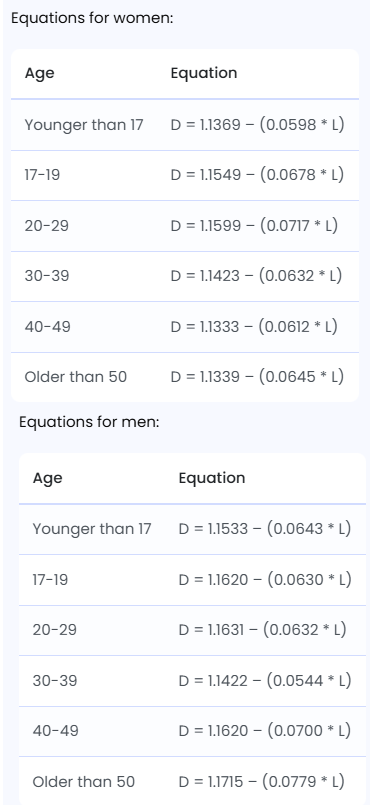1. What is a Skinfold Body Fat Calculator?
Definition: This calculator estimates your body fat percentage using the skinfold method. It takes your sex, age group, and measurements from four skinfold sites (bicep, subscapular, suprailiac, tricep) to calculate body density, which is then used to determine body fat percentage.
Purpose: It provides a practical way to estimate body fat, useful for fitness assessments, nutritional planning, and monitoring health risks associated with body fat levels.
2. How Does the Calculator Work?
The calculator takes sex, age group, and four skinfold measurements with selectable units and computes:
- Sum of Skinfolds:
- Adds the bicep, subscapular, suprailiac, and tricep measurements (converted to mm for calculation), with the result convertible to mm, m, in, or ft.
- Body Density (D):
- Based on sex and age group, using formulas like:
- For men, 20–29: \( D = 1.1631 - (0.0632 \times \log_{10}(\text{sum of skinfolds in mm})) \).
- For women, 20–29: \( D = 1.1599 - (0.0717 \times \log_{10}(\text{sum of skinfolds in mm})) \).
- Similar formulas for other age groups.
- Body Fat Percentage:
- Formula: \( \text{Body Fat Percentage (\%)} = \left( \frac{495}{\text{Body Density}} \right) - 450 \).
- Result in percentage (%).
Unit Conversions:
- Skindfold Measurements: mm, m, in, ft (e.g., 1 m = 1000 mm = 39.3701 in).
Steps:
- Select your sex.
- Select your age group.
- Input your bicep, subscapular, suprailiac, and tricep skinfold measurements with chosen units (default mm).
- Compute the sum of skinfolds, body density, and body fat percentage, with the sum convertible to different units.
3. Importance of Skinfold Body Fat Calculations
Calculating body fat percentage using the skinfold method is useful for:
- Fitness Monitoring: Tracks changes in body fat over time, helping to assess the effectiveness of fitness programs.
- Health Risk Assessment: Identifies risks associated with high body fat, such as cardiovascular disease, or low body fat, such as undernutrition.
- Personalized Nutrition: Provides data to tailor dietary plans based on body composition, focusing on fat loss or muscle gain.
4. Using the Calculator
Examples:
- Male, Age Group 20–29: Bicep = 5 mm, Subscapular = 8 mm, Suprailiac = 7 mm, Tricep = 6 mm
Sum of Skinfolds: \( 5 + 8 + 7 + 6 = 26 \, \text{mm} = 1.02 \, \text{in} \).
\( L = \log_{10}(26) \approx 1.4150 \).
Body Density: \( D = 1.1631 - (0.0632 \times 1.4150) \approx 1.0737 \).
Body Fat Percentage: \( \left( \frac{495}{1.0737} \right) - 450 \approx 11.08\% \).
- Female, Age Group 30–39: Bicep = 0.01 m (10 mm), Subscapular = 12 mm, Suprailiac = 15 mm, Tricep = 13 mm
Sum of Skinfolds: \( 10 + 12 + 15 + 13 = 50 \, \text{mm} = 0.05 \, \text{m} \).
\( L = \log_{10}(50) \approx 1.6990 \).
Body Density: \( D = 1.1423 - (0.0632 \times 1.6990) \approx 1.0349 \).
Body Fat Percentage: \( \left( \frac{495}{1.0349} \right) - 450 \approx 28.29\% \).
5. Frequently Asked Questions (FAQ)
Q: What is the skinfold method?
A: The skinfold method measures the thickness of skinfolds at specific body sites (bicep, subscapular, suprailiac, tricep) using calipers. The sum of these measurements is used to estimate body density, which is then converted to body fat percentage.
Q: Why does the formula vary by age and sex?
A: Body composition changes with age and differs between sexes. The formulas adjust coefficients to account for these variations, ensuring more accurate body fat estimates.
Q: Why can I choose different units for skinfold measurements?
A: The calculator allows flexible unit selection (mm, m, in, ft) to accommodate various measurement preferences. All inputs are converted to mm for calculation, and the sum can be converted to your preferred unit for display.
 Home
Home
 Back
Back
